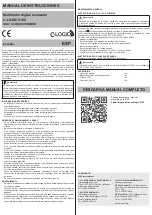
342-86400-498PS
Issue 1.2
April 2012
Page 64
Copyright
GE Multilin Inc. 2010-2012
Tying Ethernet Traffic
WARNING
When Ethernet traffic is to be passed between networks, caution must be
exercised to ensure that no Ethernet loops are created.
Using CBW Tie Connections
One way of passing Ethernet traffic between multiple ring/linear JungleMUX
networks equipped with ETHER-1000 units (or a mixture of ETHER-1000 and
ETHER-100 units) is to use CBW-tie connections. Note that individual TDM
pipes may be independently tied. If no Ethernet traffic is to be added/dropped
to/from any of the TDM pipes at a tie site, no ETHER-1000 (or ETHER-100) units
are required and traffic is tied directly between collocated optical units using 035-
86430-7X cables.
29
Otherwise, two “cascaded” ETHER-1000 (or ETHER-100)
units at the tie site are needed (Figure 33). Alternatively, in dual homing
applications between OC-48 and/or OC-3 rings only, use of one ETHER-1000
unit at a tie site is sufficient (Figure 34); however, any TDM pipes with more than
12 STS-1s (3 STS-1s for OC-3) cannot be passed across the CBW-tie link.
JMUX
(L)
JMUX
(R)
Ether-1000
JMUX
(L)
JMUX
(R)
JMUX
(L)
JMUX
(R)
Ether-1000
JMUX
(L)
JMUX
(R)
Ether-
1000
Ether-
1000
Ether-
1000
JMUX
(L)
JMUX
(R)
Ether-1000
JMUX
(L)
JMUX
(R)
JMUX
(L)
JMUX
(R)
Ether-1000
JMUX
(L)
JMUX
(R)
Ether-
1000
(See Table 3)
CBW-Tie
Figure 33:
Tying Ethernet Traffic using CBW tie connections (single tie site)
29
Maximum allowed cable length for CBW-Tie cable connections between optical units varies
depending on the CBW port mode of operation (8 ft for CBW-4 mode, 6 ft for CBW-6 mode, 4 ft
for CBW-12 mode, and 3 ft for CBW-24 mode).
















































